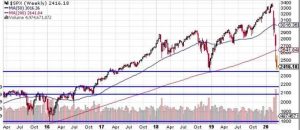If you know the end of the phrase above you are not a stranger to market volatility.
I think of Technical Analysis in terms of support and resistance levels. These come about (as far as I’m concerned) because of greed and fear. There are certain points where people say: “I wish I had bought there” or “I wish I had sold there”. Because we often operate with the same frameworks in our minds, when prices hit certain levels it causes us to want to be active. There is a whole subsector of analysis in the stock markets that studies this and it is called Technical Analysis.
At any rate, to over simplify, the points where people wish they had bought become support levels, and the points where people wish they had sold, become resistance levels.
Over the years we have seen a number of events that have caused market selloffs and subsequent rebounds.
- December 2018 – Trump shutdown
- November 2016 – Trump election
- June 2016 – Brexit
- January 2016 – oil price war (crude below $27 / barrel)

The question is, where do we wish we had bought? During the Trump shutdown? At his election? During Brexit? Or during the 2016 lows?
I don’t know where things stop falling here, but the stage has been set for a powerful rebound once any certainty comes back to the markets.
Questions to ask ourselves.
- Is the current environment temporary or permanent? Will the NHL and NBA play again? Will we see rock concerts and will we want to go on vacations?
- Is there anything our governments can do to help us get through this?
The answer to question #1 for most of us is obvious. Though many of us are thrilled that Toronto may well be NBA champions for two years in a row, I have my doubts about retaining the championship through 2021.
The answer to question #2 is more challenging for those of us who don’t follow markets and economics.
The last time the big banks cut dividends was in 1935. OSFI has dictated that they halt buybacks and discontinue dividend increases for the next 12 – 18 months. But with payout ratios around 50% Banks could see their profits drop by 50% before their payouts are even at risk. They are also being supported by the Bank of Canada in a large way.
Let’s look at the Bank of Canada only and ignore the fact that the US is currently “printing” almost 1,000,000,000,000 to support their markets. https://www.cnbc.com/2020/03/16/even-after-return-to-qe-infinity-the-federal-reserve-has-some-more-work-to-do.html
Bank of Canada actions
- They will be buying Canadian Mortgage Bonds (CMBs) on the secondary market, up to $500,000,000 per week.
- They are expanding their bond buyback program.
- They are bringing back the insured Mortgage Purchase Program, buying up to $50,000,000,000 of mortgages through the CMHC to make sure that banks get them off their books, and have lots of capital to ensure they are flush with cash.
- They cut policy rates to 0.75% – this is widely expected to be cut to 0.25%
- They will be creating liquidity by offering loans via the repo markets to banks as well on a 6 month and 12 month basis.
- OSFI cut the bank stability buffer by 125 basis points to 1% allowing $300 billion of funds for banks to lend.
- There is a 10,000,000,000 lending program to support small businesses.
And more significant fiscal stimulus measures will follow.
All of the above is just Canada, never mind what is being done in Europe, the UK, Japan, China or the United States.
The financial system looks to be very well funded and backed by our respective governments with extremely fast and aggressive actions being taken. All that is left now is for the virus to be taken seriously and for our various peoples to be supported in combatting it. But that looks to be well underway with cases in China declining and, fingers crossed, that will be followed by declining numbers in the developed world soon enough.
The question remains then, when is the market attractively priced enough to get in? And do we need to be exactly right to do extremely well? Or, will approximately right be enough to do well going forward?
Here we see the big six banks yielding north of 6%. They haven’t cut their dividends in over 90 years. I can’t tell you what the future holds but I can look at the past and see that companies that have been cash generating machines with irreplaceable assets now seem to be selling at enormous discounts to where they were mere weeks ago.
The question we need to ask ourselves is what price are we willing to pay?
Or is the sale over before we’ve had a chance to place our orders?

